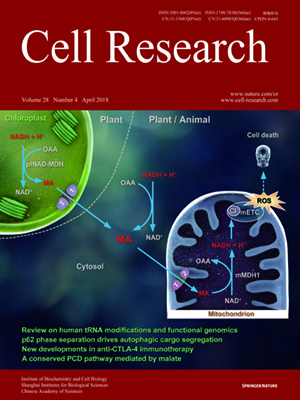
Volume 28, No 4, Apr 2018
ISSN: 1001-0602
EISSN: 1748-7838 2018
impact factor 17.848*
(Clarivate Analytics, 2019)
Volume 28 Issue 4, April 2018: 462-475
ORIGINAL ARTICLES
Poly(ADP-ribose) mediates asymmetric division of mouse oocyte
Bingteng Xie 1,2, Lu Zhang 1,2, Huiling Zhao 3, Qingyun Bai 3, Yong Fan 4, Xiaohui Zhu 1, Yang Yu 1, Rong Li 1, Xin Liang 5, Qing-Yuan Sun 6, Mo Li 1,2 and Jie Qiao 1,2
1 Center for Reproductive Medicine, Peking University Third Hospital, 100191 Beijing, China;
2 Key Laboratory of Assisted Reproduction, Ministry of Education, 100191 Beijing,China;
3 School of Basic Medical Sciences, Peking University Health Science Center, 100191 Beijing, China;
4 Key Laboratory for Major Obstetric Diseases of Guangdong Province
The Third Affiliated Hospital of Guangzhou Medical University, 510150 Guangzhou, China;
5 Tsinghua-Peking Center for Life Sciences, School of Life Sciences, Tsinghua University,100084 Beijing, China and
6 State Key Laboratory of Stem Cell and Reproductive Biology, Institute of Zoology, Chinese Academy of Sciences, 100101 Beijing, China
Correspondence: Mo Li (limo@hsc.pku.edu.cn) or Jie Qiao (jie.qiao@263.net)Bingteng Xie and Lu Zhang contributed equally to this work.
Before fertilization, mammalian oocyte undergoes an asymmetric division which depends on eccentric positioning of the spindle at the oocyte cortex to form a polar body and an egg. Since the centriole is absent and, as a result, the polar array microtubules are not fully developed in oocytes, microtubules have seldom been considered as required for eccentric positioning of the spindle, while actin-related forces have instead been proposed to be primarily responsible for this process. However, the existing models are largely conflicting and the underlying mechanism of asymmetric division is still elusive. Here we show that poly(ADP-ribose) (PAR) is enriched at mouse oocyte cortical area throughout meiosis. Specific removal of cortical PAR results in an ectopic spindle and a failure of asymmetric division. During spindle migration, when the spindle deviates from the center of oocyte by a pushing force of cytoplasmic actin, the short polar array microtubules emanating from the juxtacortical spindle pole extend to the cortex and penetrate into cortical PAR, docking and stabilizing the spindle at the cortex which facilitates the asymmetric division. This process depends on the affinity between PAR and microtubule-associated proteins such as Spindly, which contributes to a physical link for cortical PAR and the spindle. Notably, fusing a PAR-binding domain to end-binding protein 3, a plus-end tracking protein at the polar array microtubules, restores the asymmetric division of oocytes with Spindly knockdown. Thus, our work demonstrates a comprehensive mechanism for oocyte spindle positioning and asymmetric division.
10.1038/s41422-018-0009-7
FULL TEXT | PDF
Browse 1791


